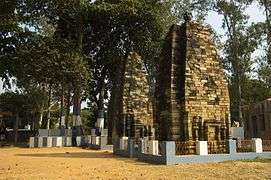Jain temple
| Part of a series on |
| Jainism |
|---|
 |
|
Jain prayers |
|
Ethics |
|
Major sects |
|
Festivals |
|
|
A Jain temple is the place of worship for Jains, the followers of Jainism,[1] Derasar is a word used for a Jain temple in Gujarat and Rajasthan. Basadi is a Jain shrine or temple.[2] The word is generally used in South India, as well as in Maharashtra. Its historical use in North India is preserved in the names of the Vimala Vasahi and Luna Vasahi temples of Mount Abu. The Sanskrit word is vasati, it implies an institution including residences of scholars attached to the shrine.[3]
Architecture

Jain temples are built with various architectural designs.[4] Jain temples in North India are completely different from the Jain temples in South India, which in turn are quite different from Jain temples in West India. There are two type of Jain temples:
- Shikar-bandhi Jain temple(one with the dome) and
- Ghar Jain temple (Jain house temple without dome).
All shikar-bandhi Jain temples have many marble pillars which are carved beautifully with Demi god posture. There is always a main deity also known as mulnayak in each derasar. The main part of Jain temple is called "Gambhara" (Garbha Graha) in which there is the stone carved God idol. One is not supposed to enter the Gambhara without taking a bath and without wearing puja (worship) clothes.
A Jain temple which is 100 years old is called a Tirtha.
The main deity of a Jain temple is known as a mula nayak.[5]
A Manastambha (column of honor) is a pillar that is often constructed in front of Jain temples. It has four 'Moortis' i.e. stone figures of the main god of that temple. One facing each direction: North, East, South and West.[6]
Etiquette
There are some guidelines to follow when one is visiting a Jain temple:[7]
- Before entering the temple, one should bathe and wear fresh washed clothes or some special puja (worship) clothes - while wearing these one must neither have eaten anything nor visited the washroom. However, drinking of water is permitted.
- One should not take any footwear(including socks) inside the temple. Leather items like a belt, purse etc. are not allowed inside the temple premises.
- One should not be chewing any edibles (food, gum, mints, etc.), and no edibles should be stuck in the mouth.
- One should try to keep as silent as possible inside temple.
- Mobile phones should not be used in the temple. One should keep them switched off.
Prevailing traditional customs should be followed regarding worshipping at the temple and touching an idol. They can vary depending on the region and the specific sect.
Gallery
India
 Jal Mandir, Shikharji
Jal Mandir, Shikharji Ellora Jain cave basadi
Ellora Jain cave basadi






.jpg)




.jpg)
 Shree Dharmachakra Prabhav Tirth, Gajpanth
Shree Dharmachakra Prabhav Tirth, Gajpanth
 Jaina caves at Gopachal Hill, Gwalior Fort
Jaina caves at Gopachal Hill, Gwalior Fort


 Ancient Jain temples at Pakbirra, Purulia, West Bengal
Ancient Jain temples at Pakbirra, Purulia, West Bengal
 Jain Temple complex, Deogarh
Jain Temple complex, Deogarh
Outside India
 Jain Temple, Potters Bar, Hertfordshire
Jain Temple, Potters Bar, Hertfordshire The original Gori Temple with 52 domes, Nagarparkar
The original Gori Temple with 52 domes, Nagarparkar
.jpg)
See also
| Wikimedia Commons has media related to Jain temples. |
Notes
- ↑ Babb, Lawrence, A (1996). Absent lord: ascetics and kings in a Jain ritual culture. Published University of California Press. p. 66.
- ↑ "Basadi".
- ↑ "Architecture of the Indian Subcontinent - Glossary".
- ↑ Jain temples in India and around the world,Laxmi Mall Singhvi, Tarun Chopra, Himalayan Books, 2002
- ↑ Jaina Iconography, Volume 1 of Jaina-rūpa-maṇḍana, Umakant Premanand Shah, Abhinav Publications, 1987,p. 149
- ↑ http://www.pluralism.org/religion/jainism/introduction/tirthankaras
- ↑ CultureShock! India: A Survival Guide to Customs and Etiquette, Gitanjali Kolanad, Marshall Cavendish International Asia Pte Ltd, 2008 p. 45
External links
- 2 idols stolen from Basadi
- Jain basadi to be renovated
- Basadi at Moodabidri
- Mysore basadi
- History
- Jaim basadi
- An ancient site connected with Jainism
- Touch of wonder to pilgrimage
- The Jain Legacy In Karnataka
- Karnataka’s hotbed of Jain religion
- Derasar and Dargah coexist in Gandhi's Gujarat
- Jaina Architecture in India, Comprehensive study of Jain architecture with high quality photos.
- Photos of Mulnayak in Jain Temples
- List of jain temples and tirths in India
